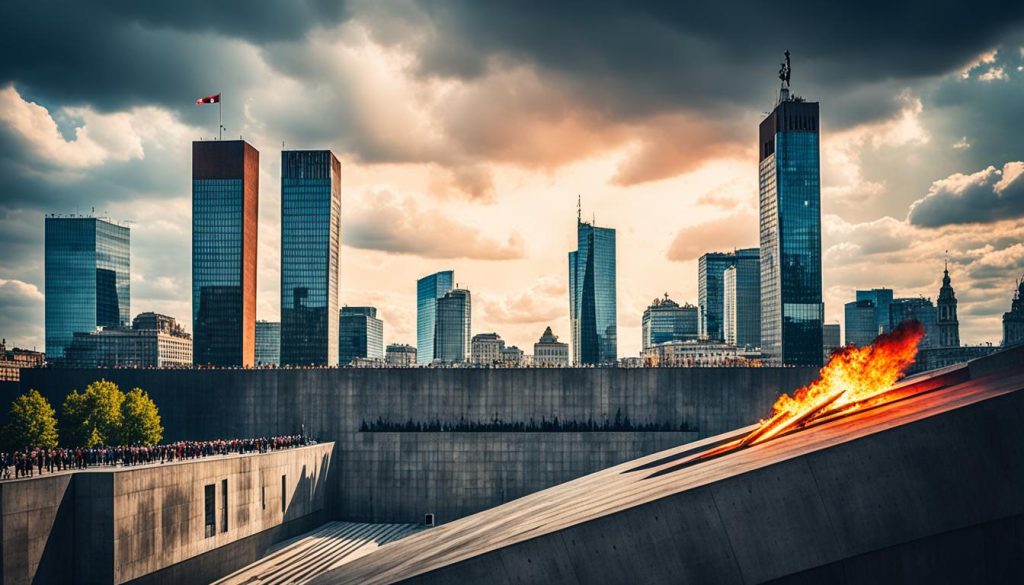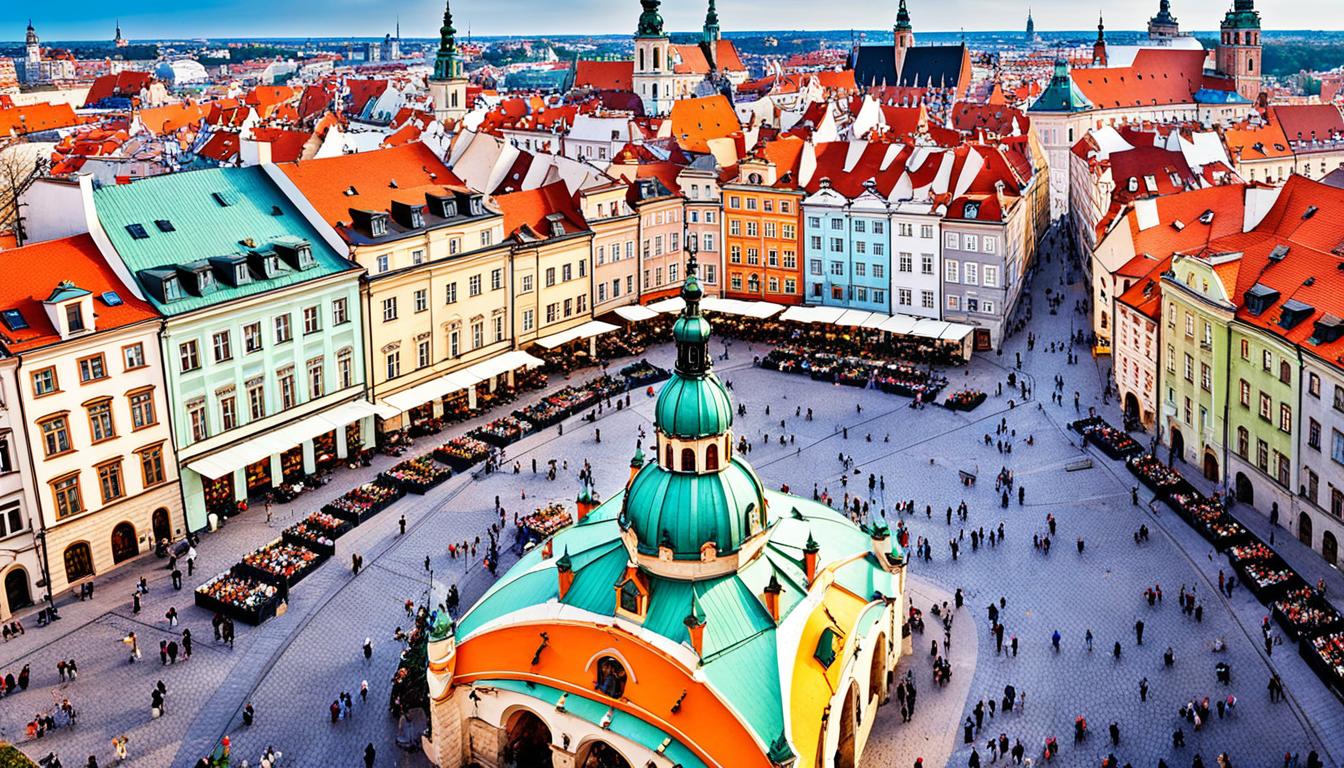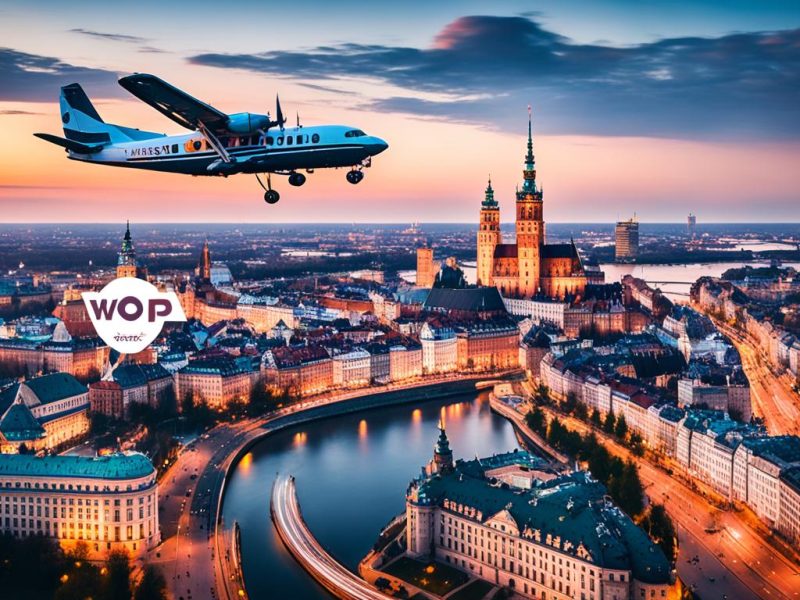Warsaw, Poland’s capital, is a testament to cultural endurance. It offers a mix of modernism and nature. Here, visitors find cultural attractions that tell the story of its rebirth.
The city’s charm comes from its blend of history and modern life. It captivates everyone who explores its streets.
Key Takeaways
- Warsaw is celebrated for its resilience and diverse cultural scenes.
- The capital of Poland is a harmonious blend of historic and modern attractions.
- Cultural enthusiasts have a wealth of attractions to explore in the city.
- Warsaw’s unique history enriches the travel experience for tourists.
- The city’s green spaces offer visitors a serene respite amidst urban exploration.
- Poland’s capital is an evolving story of revival and rich heritage, waiting to be discovered.
The Historical Significance of Poland’s Capital
Warsaw is the heart of Poland’s national identity. It holds memories of the country’s history, showing resilience and triumph. Its streets and landmarks let visitors explore stories that shaped the nation.

Warsaw’s Old Town: A UNESCO World Heritage Site
Warsaw’s Old Town is a symbol of the city’s spirit. Recognised as a UNESCO World Heritage Site, it was rebuilt after World War II. It shows the past through its cobblestoned streets, medieval structures, and market squares.
The Royal Route: Tracing the Path of Monarchs
Walking the Royal Route takes visitors on a royal journey. It is lined with beautiful palaces, churches, and monuments. This highlights Poland’s royal heritage and architectural beauty.
Historical Monuments and Museums Showcasing the Past
In Warsaw, you can feel a deep respect for history through monuments and museums. The Warsaw Uprising is commemorated. The POLIN Museum of the History of Polish Jews tells of diverse cultures. Each place is a reminder of important events and influences in Poland.
| Historical Site | Significance | Location |
|---|---|---|
| Warsaw Uprising Museum | Chronicling the 1944 resistance against occupation | Grzybowska 79, Warsaw |
| King Sigismund’s Column | Iconic symbol of Royal Warsaw | Castle Square, Warsaw |
| The Royal Castle | A former residence of Polish monarchs, reconstructed marvel | Plac Zamkowy 4, Warsaw |
| St. John’s Archcathedral | One of oldest churches in Warsaw, Gothic architecture | Świętojańska 8, Warsaw |
Poland’s Capital: A Melting Pot of Arts and Culture
Warsaw is a vibrant cultural hub in Poland. It’s filled with art galleries and cultural events. Art lovers find collections here ranging from classic Polish art to modern pieces. These works show Warsaw’s rich history and its dedication to new ideas and expression.
The Warsaw theatre scene is just as lively. The National Theatre and the Grand Theatre put on shows that highlight Polish drama. Theatre fans can see a mix of historical and modern productions in these places.
Warsaw is also known for its Polish music. The famous Warsaw Philharmonic leads in orchestral music. There are also jazz clubs that offer music every night. Here, you can enjoy classical music or more modern tunes.
The city loves movies, shown through its many film festivals. These festivals feature a wide range of films. They are a place for both experienced and new filmmakers to meet and celebrate cinema. The festivals show new films and look back at the history of movies.
Warsaw has long established itself as a beacon for cultural enlightenment, with its art galleries, theatres, music, and film festivals all contributing to a thrilling matrix of Polish artistry.
Warsaw is a centre of culture, drawing people to its events and spectacles. Walking through the city is like exploring a world of creativity. Each visitor discovers their own unique connection to culture in Poland’s capital.
Conclusion
To wrap up, Warsaw is much more than just a place for photos. It’s a city filled with life, where every street has a story. Those who visit Warsaw are treated to a mix of culture and history. The city shows how Poland has overcome tough times, linking past to the vigorous now.
Warsaw openly shows its past sorrows and successes. This offers a deep learning experience. It touches hearts and sparks curiosity. A trip here lets you be part of Warsaw’s story, one that’s alive and evolving with its people. As you explore, you experience Polish culture and pride deeply.
Finally, Warsaw is a call to adventure, celebrating resilience and change. It offers intriguing sights for those eager to learn and quiet spots for reflection. Visitors gain more than memories; they gain deep respect for a thriving city. Warsaw makes sure everyone’s visit becomes a key chapter in their life story.
FAQ
What makes Warsaw a significant tourist destination?
Warsaw, the capital of Poland, shines with cultural and historic vibrancy. It’s known for its remarkable ability to endure tough times. The city blends green parks and modern buildings with historical sites and art spaces. This mix offers tourists a rich variety of experiences.
Can visitors experience historical landmarks in Warsaw?
Yes, Warsaw has many historical landmarks. One notable site is the UNESCO-listed Old Town, rebuilt after World War II. Along the Royal Route, you’ll see palaces, churches, and statues. They tell the tale of Polish royalty’s past.
What cultural experiences does Poland’s capital offer?
Warsaw is rich in culture, with art galleries, theatres, and music venues. It houses the National Theatre and the Grand Theatre. Culture lovers will enjoy the Warsaw Philharmonic. There’s traditional Polish art and modern events for everyone.
How do Warsaw’s museums and monuments contribute to understanding Poland’s history?
The city’s museums and monuments highlight Poland’s complex history. The Warsaw Uprising Museum focuses on the heroic 1944 events. The POLIN Museum explores the history of Polish Jews. These places make the nation’s history come alive through education.
What is the best time of year to visit Warsaw for cultural events?
Warsaw holds cultural events all year. Yet, summer and early autumn are ideal. This period brings film festivals, outdoor concerts, and art events. They showcase the city’s lively culture.
What makes Warsaw’s Old Town unique?
Warsaw’s Old Town is special because of its history and rebuild after World War II. It represents the city’s spirit. With its quaint alleys, colorful buildings, and charming cafes, it reflects its past beauty.
Are there suitable activities for history enthusiasts in Warsaw?
History buffs will find plenty in Warsaw. They can join guided tours of historic places. There are museums about Poland’s history and trails commemorating important events.
Is it possible to enjoy performances of Polish music in Warsaw?
Yes, Warsaw is perfect for experiencing Polish music. The famous Warsaw Philharmonic offers concerts. The city also has jazz clubs and venues for live music. Here, one can enjoy both traditional and modern Polish music.
What are some must-see attractions for a first-time visitor to Warsaw?
First-timers should not miss the Royal Castle and the Palace of Culture’s views. They should visit the Warsaw Rising Museum and Łazienki Park. Don’t overlook the lively cafes and delicious food either.
How accessible is Warsaw for international travellers?
Warsaw welcomes international travellers easily, thanks to Warsaw Chopin Airport. It has a modern public transport system, including buses, trams, and a subway. This makes exploring Poland’s capital city effortless.



